Oscillators
A synthesizer is a combination of different parts like amplifiers, filters, LFOs but also oscillators. What is an oscillator, how does it work, and how can you use it in your music productions?
All synthesizers have oscillators, often more than one. These tone generators play a big role in the final sound. An oscillator generates a steady pitch which can be played musically by a keyboard.
Analog vs Digital Oscillators
Analog oscillators use a bunch of transistors, resistors, and capacitors to create a repeating, or, oscillating waveform. Since analog electronics are not perfect, they fluctuate over time and temperature. These subtle variations result in a sound that’s ‘warm’ and ‘deep’, albeit hard to tune at times.
Digital models apply mathematic functions or stack a bunch of sine waves on top of each other to create more complex waveshapes. Digital is pure and perfect. There are no subtle variations like in analog oscillators with the added benefit of tuning stability.

Whether you use analog or digital oscillators, they both offer the same range of options. A pitch control in octaves, semitones, or cents. Cent is just short for percentage, so 100 cents equals one semitone (half step). And 12 semitones make up one octave. Some synthesizers call this coarse and fine pitch.

There’s also a waveform selector to choose from a plethora of waveforms. The most basic being, sine, square, triangle, and sawtooth. These are named after their characteristic wave shape as seen on an oscilloscope or the waveform display when you zoom in really close in your DAW.
Sine Wave
There are four basic waveshapes and the sinewave is the most fundamental of them all. A sine wave has no harmonics. In fact, all sounds are actually made up of sine waves stacked on top of each other. Like the atoms combining into one larger molecule.
A sine wave is difficult to make with analog electronics, that’s why you won’t often find them on analog synthesizers.
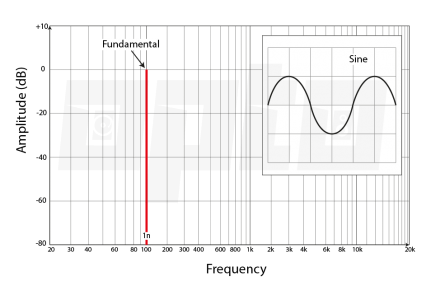
Triangle
A pure sinewave doesn’t exist in our day-to-day lives. Every sound we hear has a combination of a fundamental frequency and a bunch of harmonics. Harmonics are multiples of the fundamental frequency. Some waveforms have even harmonics, some odd, and some have both.
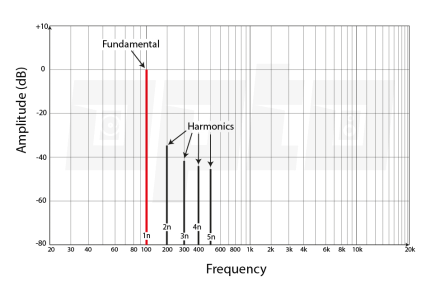
A triangle wave has only odd harmonics. So when the fundamental frequency is at 100Hz, the odd harmonics are 300Hz, 500Hz, 700Hz, and so on. The higher harmonics decrease in frequency pretty quickly. Since a triangle wave does have harmonics, it’s a bit easier to hear on smaller speakers, since higher frequencies are easier to generate.
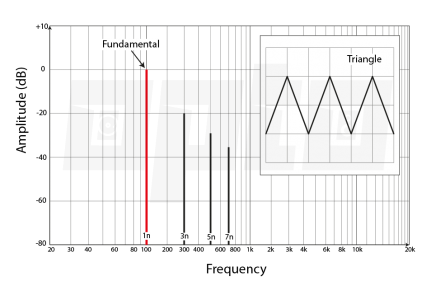
Note: only the first few harmonics are illustrated.
Square Wave
Just like the triangle wave, the square wave is also made of odd harmonics, only way louder in level. This results in a very bright and ‘nasal’ sound. A square wave has a duty cycle of 50%, which means it’s on for half the time, and off for the other half. Increasing or decreasing this duty cycle will result in a pulse wave.
The duty cycle, also referred to as pulse width, can often be manipulated by a separate control, an envelope, or LFO.
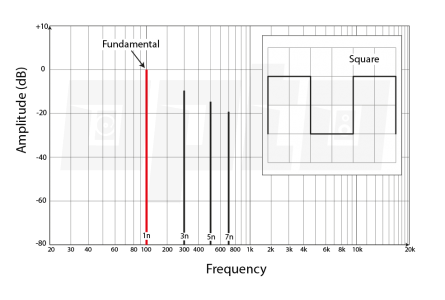
Saw Wave
Finally a sawtooth is used in almost all analog and digital synths. It’s sometimes referred to as a ‘ramp’ because that’s what it looks like. The saw wave combines both odd and even harmonics and therefore sounds less hollow than a square wave. It’s a great starting point for string and pad sounds.
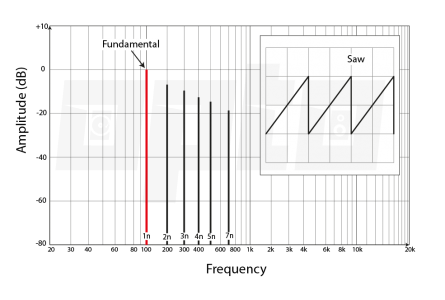
Noise Generator
A fifth waveshape that’s actually not periodic, is the noise generator. Noise basically consists of all frequencies, quickly succeeding each other in a random fashion. Noise types are indicated by colors with white noise being the most common one. White noise frequencies all have the same average loudness.
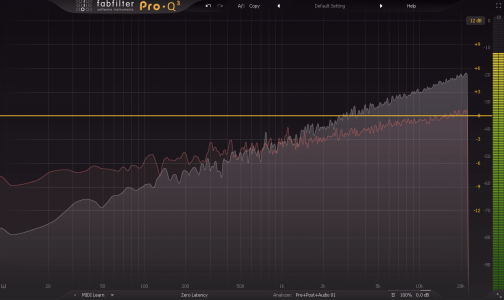
Another noise color is Pink Noise where the amplitude is the same for each octave band. This means that pink noise in the 100Hz-200Hz band is as loud as the 10kHz-20kHz band. This is the same as applying a lowpass filter with a slope of 3db/octave to a white noise signal, slowly attenuating high frequencies. Brown Noise is a bit darker and features a slope of 6db/octave.
Other Oscillator Settings
Voices
On some synthesizers, you’ll find an option to change the amount of voices. A monophonic synth usually only has 1 voice. Imagine a voice being like one singer in a choir. A singer can only sing one note at a time. The same is true for a monophonic synth that can only play one note at a time. If you play a new note the previous note is released (turned off).

A polyphonic synth has multiple voices. So if you have a polyphonic synth that has 4 voices, you can play 4 notes at a time. The weird thing is that a polyphonic synth may only show one or two oscillators. There’s actually one oscillator for each voice behind the scenes. So when you increase the number of voices on a software synth like Serum, it actually creates copies of the same oscillator, assigning one oscillator to each key. This can be demanding for your CPU, so that’s why you shouldn’t always crank the number of voices to the maximum.
Most polyphonic synths also have a switch to change the synth’s behavior to monophonic but at the same time still featuring 4 voices. This is equal to a choir where all singers sing the same notes at the same time, bringing us to the next parameter.

Unison

Unison, sometimes called Detune, spreads the pitch of all voices by a variable amount. So some notes play a bit flat, while others are slightly sharp. This emulates a real choir with real singers who never sing 100% in tune with each other. This parameter is often used to thicken a sound a little, perfect for lush pads and strings.
Panning

Most software synthesizers like Sylenth1 and Serum allow you to pan each oscillator from left to right in the stereo field. Sylenth1 also has a separate stereo knob that spreads each voice to a different place in the stereo field.
Phase
The phase parameter allows you to delay one oscillator in time with an offset between 0° and 360°. If you have 2 square wave oscillators for example with the phase of both at 0° they sum together to be twice as loud.
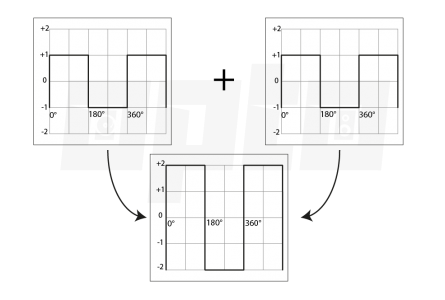
If you invert the phase of one oscillator or offset one oscillator by 180° you get no sound at all. This is because one sine wave moves up, while the other is mirrored and thus moves down at the same time. So when one sine wave has an amplitude of 1 and the other has an amplitude of -1 at the same time they cancel out because 1 – 1 = 0.
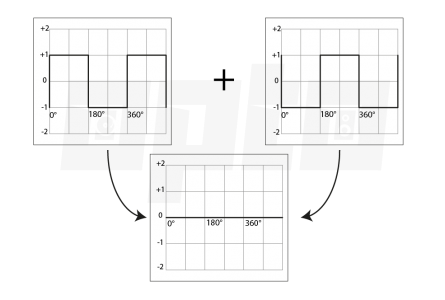
Total cancellation only happens on sine waves though. All other waveforms have harmonics, each with its own phase. But still, the phase control has a huge impact on the sound, because some harmonics will add, while others cancel out.
Retrigger
Retriggering means that each time you press a key on your keyboard the oscillator resets to the beginning of the waveform. If the retrigger is off the oscillator keeps on running whether you press a key or not. This means that the phase is different each time you press a key resulting in a slightly different sound with every keypress.
On some synthesizers like Serum, this is called Random Phase.
Oscillator sync
The last parameter I want to explain in this article is oscillator sync. Oscillator sync is when one oscillator follows another oscillator. When the main oscillator completes its cycle from beginning to end, the second oscillator restarts. By tuning oscillator 2 you can create harmonically rich sounds, often used in Dubstep and Drum & Bass music.
Like everything in music production, just play around with the controls and listen to how this affects the sound. Soon you’ll be familiar with all these parameters, and once you know these basics, you can master any synth in an instant.

